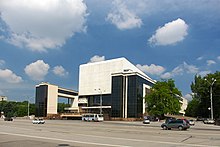Vladimir Georgievich Helreich
Vladimir Georgievich Helfreich ( Russian Владимир Георгиевич Гельфрейх ; born March 12 . Jul / 24. March 1885 greg. In St. Petersburg , † 7. August 1967 in Moscow ) was a Russian architect and university lecturer .
Life
Helreicher, son of a civil servant family, attended a private drawing school in St. Petersburg for two years after graduating from school. 1906–1914 he studied architecture at the Russian Art Academy . As a diploma thesis, he planned the State Council building under the direction of his professor LN Benois . Even during his studies, he worked in the studio of WA Shchuko , which shaped his further life.
From 1918 Helreich was WA Shchuko's partner until his death in 1939. They followed Neoclassicism and Art Deco . Their first joint project after the October Revolution was the construction of the pavilions for the Foreign Department of the All-Russian Agriculture, Crafts and Industry Exhibition in Moscow (1922–1923), which became today's exhibition of the achievements of national economy . 1927–1929 they built the new building of the Lenin Library in Moscow , on which Helreich worked until 1958. Their other projects were related to Petrograd , and they participated in many competitions.
The plans for the Palace of the Soviets , in which they took part in the first and second competitions (1932–1933) , played a major role in Helreich's and Shchuko's activities . The project was accepted by BM Iofan , with the implementation of which the architects Iofan, Helreich and Schtschuko were commissioned with their architectural collectives (1933–1939). 1935-1937 Helreich was actively involved in the restructuring of Moscow . 1936–1938 he built the Great Stone Bridge in Moscow together with Shchuko and M. Minkus . He built the government building of the Abkhaz Soviet Socialist Republic in Sukhumi . 1930–1935 he built the theater in Rostov-on-Don with Shchuko and in 1936 the Palace of Culture in Kuibyshev .
During the German-Soviet War , he was involved in the third expansion stage of the Moscow Metro . He built the Kuznetskaya station, which opened in 1943, and, together with I. Roschin, the Elektrosavodskaya station, which opened in 1944 . In 1949 he planned the Botanical Garden station (today Prospect Mira (Kolzewaja Line) ) together with M. Minkus and the sculptor G. Motowilow .
1944–1945 Helreich operated with GW Shchuko (son WA Shchukos) the reconstruction of Rzhev , and they were involved in the Khreshchatyk in Kiev and in the center of Stalingrad and Oryol . 1947–1953, together with M. Minkus, Helreich realized the project for an administrative high-rise on Smolensker Platz, one of the first high-rise buildings in Moscow, into which the Foreign Ministry of the USSR moved and which - as one of the Seven Sisters - a typical representative of socialist classicism (also Stalin -Empire ). Otherwise, he built apartment blocks in Moscow. He also built the museum and library in Birobidzhan and in 1962 the building for the Panorama Museum of the Battle of Borodino .
Helreich was a lecturer at the Wchutein from 1918 to 1935 and a lecturer at the Moscow State University for Art and Industry from 1959 to 1967 .
Helreicher found his grave in the Novodevichy Cemetery .
Honors
- Stalin Prize , 1st class (1946) for the construction of two underground stations
- Stalin Prize, 1st class (1949) for the construction of the Foreign Ministry on Smolensk Square
- Hero of Socialist Labor (1965)
- Order of Lenin (twice)
- Order of the Red Banner of Labor (three times)
- Badge of Honor of the Soviet Union (twice)
- Medal "For heroic work in the Great Patriotic War 1941–1945"
literature
- Niss A. Pekarewa: W. Hel Reich (1885-1967) . Moskowski Rabotschi, Moscow 1988, pp. 175-181 (Russian).
- Niss A. Pekarewa: Vladimir Georgievich Helreich . Architektura SSSR No. 6 (1960), pp. 51-54 (Russian).
Individual evidence
- ↑ Гельфрейх Владимир Георгиевич. Great Soviet Encyclopedia 1969.
- ↑ Moscow Encyclopedia: SO Schmidt . Moskwowedenije, Moscow 2007, Volume 1, p. 362, ISBN 978-5-903633-01-2 (Russian).
- ↑ Nikolai S. Atarow: The Palace of the Soviets . Sowjetski Rabotschi, Moscow 1940, p. 45 (Russian).
Web links
| personal data | |
|---|---|
| SURNAME | Help, Vladimir Georgievich |
| ALTERNATIVE NAMES | Гельфре́йх, Влади́мир Гео́ргиевич (Russian) |
| BRIEF DESCRIPTION | Russian architect and university professor |
| DATE OF BIRTH | March 24, 1885 |
| PLACE OF BIRTH | St. Petersburg |
| DATE OF DEATH | 7th August 1967 |
| Place of death | Moscow |


